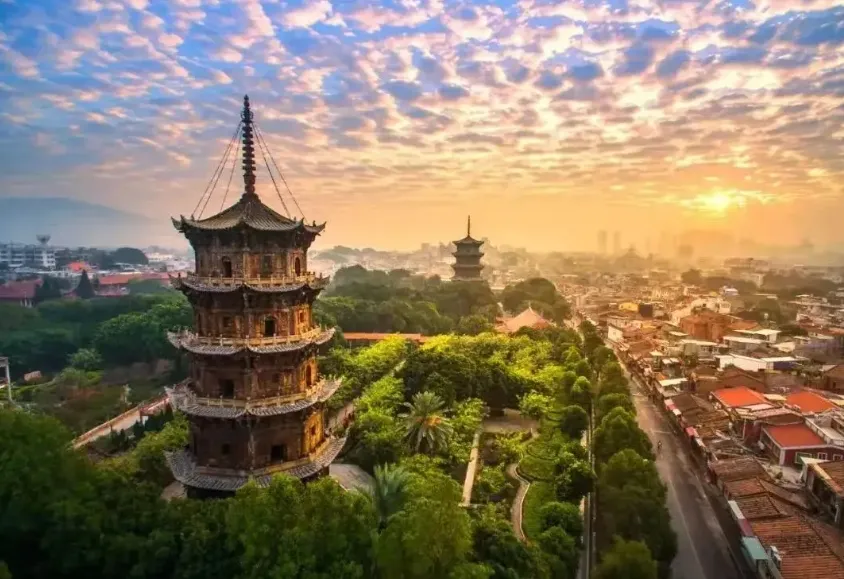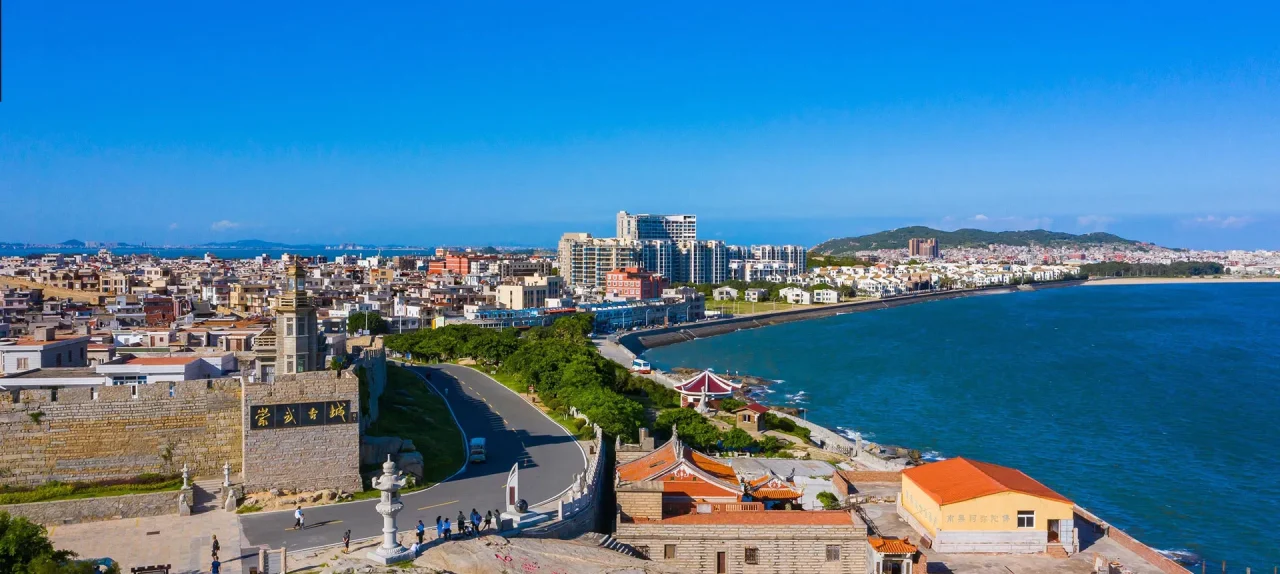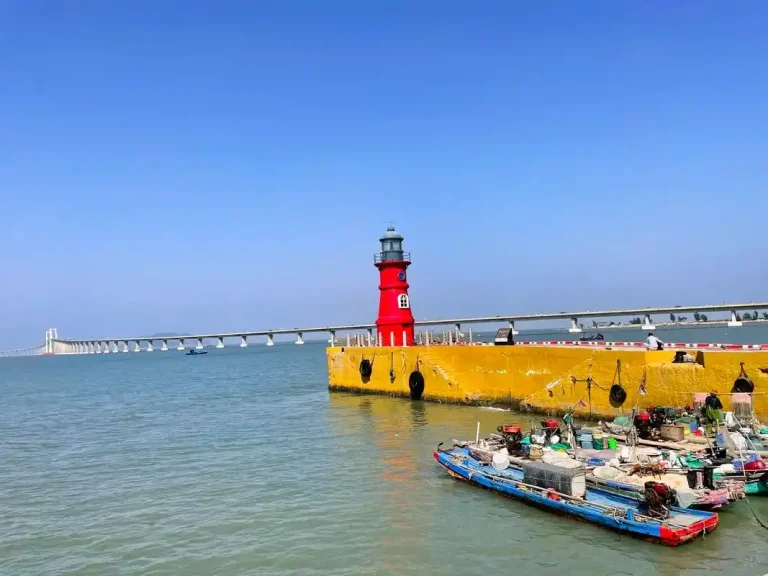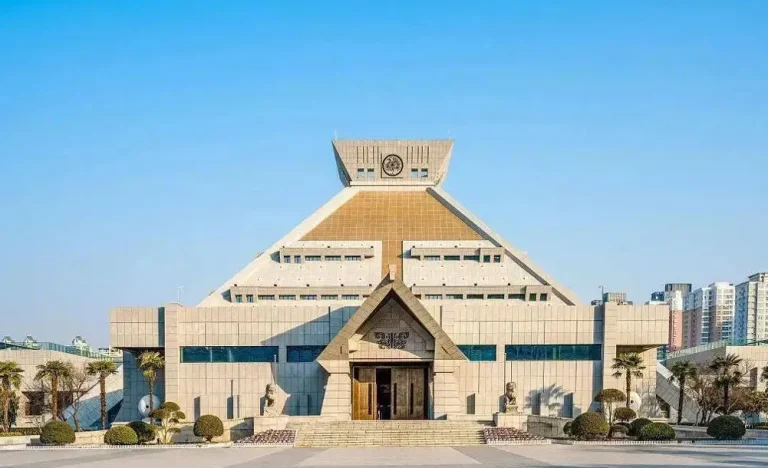
Table of Contents
Prologue: A Millennia-Long Dialogue Between Kaiyuan Temple and Quanzhou
In the morning bells and dusk drums of West Street, Li Cheng District, Quanzhou, Quanzhou Kaiyuan Temple has stood quietly for more than 1,300 years. This ancient temple, which was built in the second year of the Tang Dynasty, has witnessed the sails and shadows of the Maritime Silk Road, experienced the prosperity of Quanzhou in the Song and Yuan Dynasties, and carries the genetic code of Minnan culture.
When visitors stroll along the Lotus Path of the Kaiyuan Temple, what they are stepping on is not only a thousand years of stone slabs, but also an epic poem of Quanzhou engraved on the stone. This article will take you to decode one of the most complete existing Buddhist temples of the Song Dynasty in China and reveal its unique value as a World Heritage Site.
Interwoven Timelines: Kaiyuan Temple’s Past and Present
From Lotus Temple to Maritime Silk Road Landmark
In 686 AD, wealthy Quanzhou merchant Huang Shougong, inspired by the legendary overnight blossoming of white lotuses in his mulberry garden, donated his land to build a temple, initially named “Lotus Temple” (Lianhua Si). This legendary origin, recorded in the “Quanzhou Prefecture Gazetteer,” is known as the “Mulberry-Lotus Dharma Realm.” In 738 AD, Emperor Xuanzong of Tang decreed that each of the ten major prefectures build a Kaiyuan Temple. The Quanzhou temple thus gained its current name, solidifying its status as an official state temple.
A Millennia of Craftsmanship Through Dynastic Construction
The temple’s existing structures span the Tang, Song, Yuan, Ming, Qing, Republic of China, and modern periods, forming a unique chronological layering:
- Song Dynasty Relics: The Sumeru pedestal of the Mahavira Hall’s (Hundred-Pillar Hall) moon platform retains sphinx carvings dated to 1095 AD (Northern Song).
- Yuan Dynasty Fusion: The flying apsara musicians (Feitian Yueji) adorning the Amrita Ordination Altair showcase the blending of Yuan Dynasty Buddhist art with Hindu influences.
- Ming Dynasty Renovation: Zheng Zhilong spearheaded major renovations during the Chongzhen era (1628-1644), leaving behind artistic treasures like the apsara musicians.
- Modern Protection: Designated a National Key Cultural Relics Protection Unit in 1982 and inscribed on the UNESCO World Heritage List in 2021.
Contemporary Revival: Numbers Tell the Tale
According to Quanzhou’s Cultural and Tourism Bureau, Kaiyuan Temple welcomed 375,800 visitors during the 2024 National Day holiday, a 61.5% increase compared to 2019. This surge reflects the contemporary revival of the “World Museum of Religions” and stands as a vivid testament to the inclusive nature of Chinese civilization.
Architectural Code: Deconstructing the Aesthetic DNA of Southern Min Architecture
A Spatio-Temporal Symphony Along the Central Axis
Strolling along the 120-meter central axis reveals:
- Ziyun Screen Wall (紫云屏): The inscription “This land was anciently called the Buddha Kingdom” echoes Quanzhou’s moniker “Buddha Kingdom of South Fujian.”
- Heavenly King Hall (天王殿): Its hip-and-gable roof features the iconic “Swallowtail Ridge” (Yanwei Ji), a hallmark of Southern Min architecture.
- Mahavira Hall (大雄宝殿 – Hundred-Pillar Hall): Supported by 100 stone pillars, 24 apsara musicians carved into the brackets hold instruments of Nanyin music.
- Amrita Ordination Altair (甘露戒坛): One of only three surviving ancient ordination altairs in China, its complex “Spider-Web” bracket system uses no nails.
- Scripture Library (藏经阁): A two-story flush-gable roof building rebuilt in the Qing Dynasty, housing treasures like the Ming Dynasty Tripitaka.
The Twin Pagodas: Masterpieces of the Stone Pagoda Kingdom
The construction history of China’s tallest stone pagodas (East Pagoda: 48m, West Pagoda: 44m) is remarkable:
- East Pagoda (Zhenguo Pagoda – 镇国塔): Founded in 865 AD, rebuilt multiple times, the current structure dates to the Southern Song (1238 AD).
- West Pagoda (Renshou Pagoda – 仁寿塔): Built a decade earlier than the East Pagoda; its fourth-floor relief of the “Monkey Pilgrim” is confirmed as a prototype for “Journey to the West.”
- Seismic Miracle: Survived the 1604 magnitude 8 earthquake unscathed. Modern engineers attribute this to its unique “tapered profile damping” design.
Cultural Fusion in the Details
Kaiyuan Temple’s architectural details reveal fascinating syncretism:
- Hindu lion pillars before the Mahavira Hall.
- Apsara musicians at the Amrita Altair holding Christian crosses.
- Islamic crescent moon and star motifs on the Scripture Library eaves.
These elements collectively embody Quanzhou’s reputation as a “World Museum of Religions.”
Three Sacred Treasures: Cultural Memories Across Time
The Ancient Mulberry-Lotus: A Living Relic
The millennium-old mulberry tree within the temple, though its trunk is split, sprouts green leaves every year, a living testament to the “White Lotus Mulberry” legend. A nearby stele records its miraculous recovery after being struck by lightning in 1925, hailed by scientists as a “phoenix nirvana in the plant kingdom.”
Ming Dynasty “Twenty-Four Filial Exemplars” Murals
Preserved in the eastern corridor of the Mahavira Hall are rare Ming Dynasty Buddhist-themed murals depicting the Confucian “Twenty-Four Filial Exemplars.” Painted using the “low-relief” technique, they exemplify the fusion of Confucian ethics and Buddhist thought in Ming Quanzhou.
Master Hongyi Memorial Hall
Housed within the Zunsheng Courtyard, this hall preserves manuscripts and letters from Master Hongyi’s later years spent in Quanzhou. His final inscription before passing in 1942 – “Chant the Buddha’s name, but never forget to save the nation” – still radiates patriotic spirit.
Travel Guide: A Journey Through Millennia
Best Times to Experience
- Dawn (6:30-8:30 AM): Avoid crowds, experience monks’ morning chanting.
- Dusk (4:00-5:15 PM): Silhouettes of the Twin Pagodas cast upon the Amrita Altair’s caisson ceiling.
- 26th Day of Lunar Month: Experience the traditional “Qin Fo Ri” (Devotion Day) with grand offerings.
In-Depth Itineraries
- 3-Hour Highlights Route: Ziyun Screen → Heavenly King Hall → Mahavira Hall → Amrita Altair → Scripture Library → East Pagoda → West Pagoda → Master Hongyi Memorial Hall.
- 6-Hour Deep Dive Route (Adds): Ancient Mulberry Tree → Unicorn Wall → Anyang Courtyard → Quanzhou Buddhist Museum → Xijie Historic Cultural District.
Nearby Attractions
- Southern Shaolin Temple (15-min drive): Experience Quanzhou Nanquan (Southern Fist) culture.
- Museum of Overseas Communication History (20-min walk): Discover the glory of the “Greatest Oriental Port.”
- Xunpu Village (25-min drive): Experience fishing village culture with Zanhua headdresses and Oyster Shell Houses.
Flavors of Kaiyuan: Vegetarian Fare Meets Tea Aroma
Temple Vegetarian Dining
- Mahavira Hall Vegetarian Restaurant: Try the “Luohan Zhaimian” (Arhat Noodles) with temple-grown vegetables.
- Amrita Altair Tea House: Savor Anxi Tieguanyin tea served in Dehua white porcelain.
Nearby Food Map (Xijie & Jinyu Lane)
- Yafo Spring Pancake Shop: Century-old spring rolls (~¥12/person).
- Kangzhuang Manjian Gao: Traditional brown sugar cakes (~¥8/person).
- Donglai Radish Salad: Refreshing sour radish salad (~¥5/person).
- Maritime Silk Jinfeng Yuanxiao: Handmade glutinous rice balls (~¥10/person).
Practical Info: Begin Your Journey Through Time
| Item | Details |
|---|---|
| Opening Hours | 6:30 AM – 5:30 PM (Last entry at 5:00 PM) |
| Admission | Free (Mandatory reservation via “Quanzhou Kaiyuan Temple” WeChat official account) |
| Transport | Bus routes 1, 2, 6, 14 to “Kaiyuan Temple West Gate”; Drive & park at Xijie Smart Parking Lot (~¥30/day) |
| Guided Tours | Official guides: ¥150/hour (Requires 3-day advance booking) |
| Best Season | Mar-May (Cherry Blossoms), Sept-Nov (Pleasant Autumn) |
Epilogue: Encountering the Beauty of Civilization in an Ancient Temple
When the afterglow of the setting sun gilds the east and west twin towers of the Kaiyuan Temple, and when the melody of Nanyin sounds in front of the Ziyun screen, the Kaiyuan Temple in Quanzhou has told us for 1300 years that civilization is perpetuated by exchange and culture is evergreen by tolerance.
It is not only a place of pilgrimage for Buddhists, but also a spiritual home for every Chinese to find their cultural roots.
The next time you set foot on Quanzhou’s West Street, slow down and listen to the story of Chinese civilization told by this thousand-year-old temple in the morning bells and evening drums of the Kaiyuan Temple.
Quanzhou Travel Guide
Quanzhou, an ancient city certified by UNESCO as the starting point of the Maritime Silk Road, holds the most complete memory of China’s Song and Yuan maritime trade.





